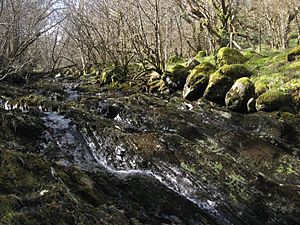Nod Glas Formation facts for kids
Quick facts for kids Nod Glas FormationStratigraphic range: Hirnantian Stage |
|
|---|---|

River bed of the Afon Ddu, near Dolgarrog, showing the exposed Nod Glas Formation
|
|
| Type | Formation |
| Underlies | Broad Vein Mudstone Formation |
| Overlies | Ceiswyn Formation |
| Thickness | Typically 20 metres (66 ft) to 30 metres (98 ft), up to 400 metres (1,300 ft) at the northern end |
| Lithology | |
| Primary | Mudstone |
| Location | |
| Coordinates | 53°10′37″N 3°50′27″W / 53.1770°N 3.8407°W |
| Region | Mid Wales |
| Country | Wales |
| Type section | |
| Named for | Adapted from "Blue Mark" a quarryman's term for the strata |
| Named by | W. J. Pugh |
The Nod Glas Formation is a special type of rock layer found in Mid Wales. It's also known by other names like the Nod Glas Black Shale or the Penarwel Mudstones. This rock formation was formed during the Ordovician period, which was a very long time ago!
The rocks in this formation are mostly mudstone. They are usually black and contain tiny bits of pyrite, which is sometimes called "fool's gold." When these rocks are exposed to the weather, they become soft and look a bit like coal. You can find the Nod Glas Formation stretching from Conwy in the north down towards Cardigan Bay, near places like Aberdyfi and Tywyn. However, it doesn't appear everywhere in a continuous line.
In North Wales, the Nod Glas Formation is the very top layer of rocks from the Caradoc Series. The name "Nod Glas" refers to all the black shale beds in this area. In South Wales, similar rock layers are called the Dicranograptus Shales.
Contents
Where to Find Nod Glas Rocks
The Nod Glas Formation can be found in many parts of Wales. Its thickness can change a lot from one place to another.
Nod Glas in North Wales
Between Tywyn and Aberllefenni, the Nod Glas Formation is about 25 metres (82 ft) thick. The area between Aberllefenni and Aberangell is a very important spot for studying this formation. As you go north from Corris towards Bwlch y Groes, the rock layer gets thinner and eventually disappears.
Near Dinas Mawddwy, at a place called Aber Cywarch, you can see these black shale beds with thin layers of limestone mixed in. The formation then shows up again east of Bwlch y Groes and can be found as far east as Welshpool, sometimes up to 19.5 metres (64 ft) thick. There's also another big section about 10 kilometres (6.2 mi) long west of Glyn Ceiriog.
Nod Glas in River Valleys
A significant layer of Nod Glas rocks runs along the River Conwy and Lledr Valley. In the Dolwyddelan area, these shales have been squeezed and changed by pressure. This makes them useful for quarrying slate, which is a strong, flat rock used for roofs and other things. For example, at Chwarel Ddu, these shales are quarried as slate.
You can also find more of these rocks around Betws-y-coed, where they were also quarried for slate. Near Dolgarrog, the Nod Glas Formation is much thicker, ranging from 83 metres (272 ft) to 400 metres (1,300 ft) thick.
Nod Glas on Llŷn Peninsula
There's one more place where you can find the Nod Glas Formation, on the Llŷn Peninsula. Here, it's about 16 metres (52 ft) thick and is known by a local name: the Penarwel Mudstones.
Ancient Fossils in Nod Glas
Scientists have found amazing fossils in the Nod Glas Formation, especially near Welshpool. These fossils tell us about the ancient life that lived when these rocks were forming.
Types of Fossils Found
- Graptolites: These were tiny, colonial sea creatures that looked a bit like saw blades or tuning forks. They floated in the ancient oceans.
- Conodonts: These are tiny, tooth-like fossils from an extinct group of primitive chordates.
- Trilobites: These were ancient sea bugs, a bit like modern-day crabs or lobsters, that lived on the seafloor.
Other Meanings of Nod Glas
Interestingly, the term Nod Glas was also used in Wales for something completely different! It was a name for a blue-black mark used to identify sheep.

